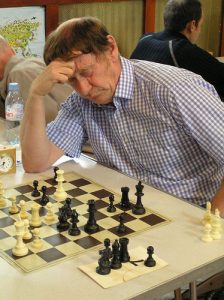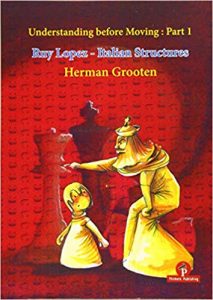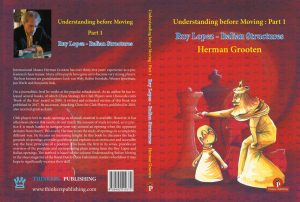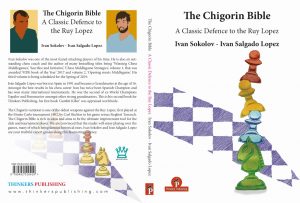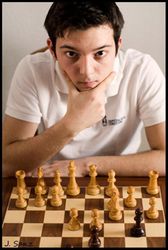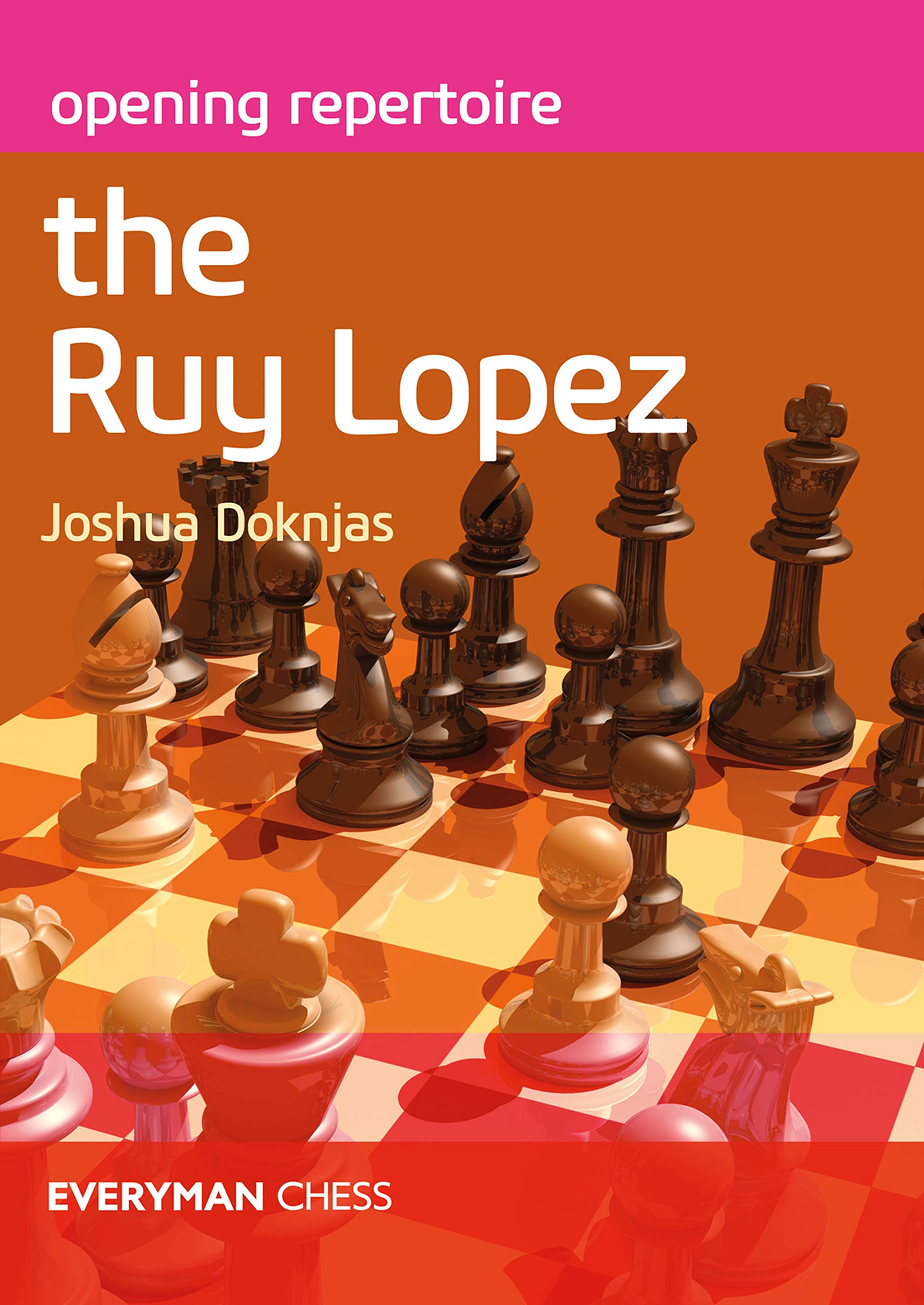
Joshua Doknjas is a FIDE Master from Canada who has enjoyed success competing internationally. He has won seven national titles for his age and tied for 1st in the 2019 U18 North American Youth Chess Championship. This is his second book for Everyman Chess.
From the book’s rear cover we have :
“The Ruy Lopez is perhaps the most classical of all chess openings. It dates back to the 16th century and has featured in the opening repertoire of every modern world champion. It is a highly flexible variation: Bobby Fischer used it to create numerous powerful strategic masterpieces. In the hands of Anatoly Karpov it led to many of his trademark positional squeezes, whereas Garry Kasparov often used it as a springboard for his typically powerful attacks.
Opening Repertoire: The Ruy Lopez is a modern examination of this perennial favourite. Joshua Doknjas has put together a repertoire for White based firmly around contemporary trends in the Lopez. He examines all aspects of this highly complex opening and provides the reader with well-researched, fresh, and innovative analysis. Each annotated game has valuable lessons on how to play the opening and contains instructive commentary on typical middlegame plans.
- A complete repertoire for White in the Ruy Lopez
- A question and answer approach provides an excellent study method
Everyman Chess have already produced several books of high quality on chess openings and have now added another one.
Here is a sample pdf
The book is divided into ten main chapters as follows :
- The Zaitsev : 9…Bb7 and Sidelines
- The Chigorin : 9…Na5
- The Breyer : 9…Nb8
- The Anti-Berlin : 4.d3
- The Open Variation
- The Anti-Marshall : 8.a4
- Systems with 5…b5 and 5…Bc5
- Systems with …g6 and …Nge7
- The Schliemann
- Rare Lines
The Ruy Lopez has been called the mother of chess openings and is undoubtedly the most challenging for anyone who plays the open game with the black pieces.
The book is divided into 3 parts. Part 1 is solely dedicated to the closed Lopez : a great favourite of Lev Aronian. Three main variations are looked at after 5…Be7 6.d4 b5 7.Bb3 d6 8.c3 00 9.h3 when 9…Bb7; the Zaitzev 9…Na5 the Chigorin; a great favourite of Paul Keres and 9…Nb8 favoured by Anatoly Karpov are each considered in detail.
The lines are investigated by examining games played by those of at least 2500 Elo with lots of discussion of other possibilities and questions giving the reader the chance to see if they can work out the correct path.
A Grischuk win against the Ziatzev is analysed, Alexei Shirov shows us how to face the Chigorin with nice wins by Ray Robson with Grischuk and Maxime Vachier-Legarve dismanting the Breyer Variation.
Part2 starts by looking at the notorious Berlin Defence and recommends that White plays 4.d3 which has been the move favoured By Magnus Carlsen and Fabiano Caruana in recent years.
Both 4…d6 and 4…Bc5 are studied the latter in some depth.
The Open variation with 5…Nxe4 by black is analysed in Chapter 5.
The main line 6.d4 b5 7.Bb3 d5 8.d4xe5 Be6 9.c3 is chosen as surprise recommendation as I have played the Open Variation for about 30 years and always thought 9.Nbd2 chosen by Karpov in many games to be the strongest continuation. After 9…Bc5 10 Qd3 is Doknjas suggestion probably chosen to avoid the dangerous Dilworth Attack.
The top game here is a rapid game between heavyweight giants Anish Giri and Vishy Anand and, as usual, White wins.
There is no analysis of the Marshall Defence as 8.a4 avoiding it is the repertoire recommendation.
This was Kasparov’s choice in game 1 of his 1993 PCA world championship match versus Nigel Short. Again, games by Giri and Vachier-Legarve are given as examples for White players. Unusually there is a draw for Black when Ding Liren defends the black side : unusual for this book which has a heavy white bias.
The Arkhangelsk with both 6…Bb7 and the very modern 6…Bc5 often favoured by Shirov is discussed with 7.d3 recommended against the former and 7.c3 against the latter.
The closing chapters in Part 3 look at the rarer moves 3…Nge7 3…g6 3…Nd4 and 3..d6 lines are covered next.
For completeness, there is a chapter on the 3…f5 Schliemann and 4.d3 is the recommended way forward when white intends to snatch a pawn and challenge black to prove he has compensation.
This book is aimed at players from about 120 ECF and upwards though promising juniors who play 1.e4 and are wondering what to choose against the open game are likely to benefit.
The book is nicely presented with good clear print and many diagrams as well as lots of good games.
Colin Lyne, Farnborough, Hampshire, 8th February, 2020
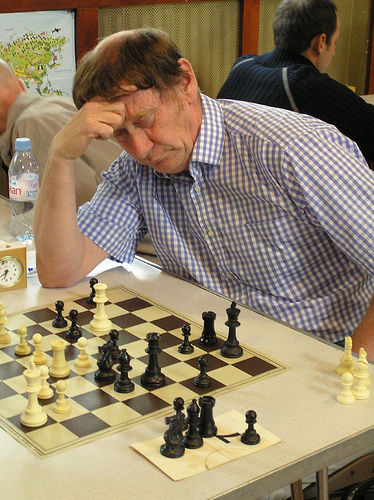
Book Details :
- Paperback : 288 pages
- Publisher: Everyman Chess (30 Nov. 2019)
- Language: English
- ISBN-10: 1781945411
- ISBN-13: 978-1781945414
- Product Dimensions: 17.1 x 1.8 x 23.8 cm
Official web site of Everyman Chess





